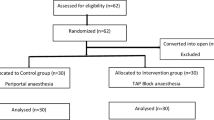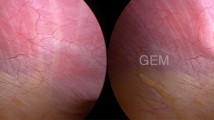Abstract
Purpose
Laparoscopic inguinal hernia repair (IHR) may lead to early postoperative pain. Therefore, opioid and non-opioid analgesic agents are often administered in the post-anesthesia care unit (PACU). To reduce the postoperative cumulative need of analgesic medication, as well as to accelerate the physical recovery time, the transversus abdominis plane (TAP) block has recently been studied. The TAP block is a regional anesthesia technique. Even though there is evidence about the efficacy of the block used in procedure such as an open inguinal hernia repair, the evidence regarding its use for the TAPP (transabdominal preperitoneal) technique remains low. We aim to provide more sufficient evidence regarding this topic.
Methods
A monocentric retrospective observational study investigating the effect of the TAP block prior to primary IHR in TAPP technique was conducted. The data of 838 patients who were operated on using this technique from June 2007 to February 2019 were observed. 72 patients were excluded because of insufficient information regarding their analgesic medication protocol. The patients’ data were taken from their files.
Results
The patients in the TAP block group (n = 364) did not differ statistically significantly compared to the control group (n = 402) in terms of gender, BMI and age. Individuals of the TAP block group experienced less postoperative pain in the PACU (p < 0.001) and received less analgesic medication (morphine, oxycodone, piritramide, acetaminophen; p < 0.001).
Conclusion
We assume that the TAP block is a sufficient approach to reduce postoperative pain and analgesic medication administration for IHR in TAPP technique.
Similar content being viewed by others
Change history
09 June 2020
The updated table has been copied below.
References
Johns N et al (2012) Clinical effectiveness of transversus abdominis plane (TAP) block in abdominal surgery: a systematic review and meta-analysis. Colorectal Dis 14(10):e635–e642
Mughal A et al (2018) Laparoscopic-assisted transversus abdominis plane block as an effective analgesic in total extraperitoneal inguinal hernia repair: a double-blind, randomized controlled trial. Hernia 22(5):821–826
International guidelines for groin hernia management (2018) Hernia 22(1):1–165
Petersen PL et al (2013) The effect of transversus abdominis plane block or local anaesthetic infiltration in inguinal hernia repair: a randomised clinical trial. Eur J Anaesthesiol 30(7):415–421
Andersen FH, Nielsen K, Kehlet H (2005) Combined ilioinguinal blockade and local infiltration anaesthesia for groin hernia repair—a double-blind randomized study. Br J Anaesth 94(4):520–523
Zhou Y et al (2019) Ilioinguinal/iliohypogastric nerve block versus transversus abdominis plane block for pain management following inguinal hernia repair surgery: a systematic review and meta-analysis of randomized controlled trials. Medicine (Baltimore) 98(42):e17545
Kumar S (2006) Laparoscopically guided ilioinguinal nerve block for groin hernia repair. J Laparoendosc Adv Surg Tech A 16(6):562–564
Abdallah FW, Chan VW, Brull R (2012) Transversus abdominis plane block: a systematic review. Reg Anesth Pain Med 37(2):193–209
Gao T et al (2017) Evaluation of Transversus Abdominis Plane (TAP) Block in Hernia Surgery: a meta-analysis. Clin J Pain 33(4):369–375
Takebayashi K et al (2015) Efficacy of transversus abdominis plane block and rectus sheath block in laparoscopic inguinal hernia surgery. Int Surg 100(4):666–671
Arora S et al (2016) Transversus abdominis plane block for laparoscopic inguinal hernia repair: a randomized trial. J Clin Anesth 33:357–364
Nagata J et al (2017) Transperitoneal rectus sheath block and transversus abdominis plane block for laparoscopic inguinal hernia repair: a novel approach. Asian J Endosc Surg 10(3):336–338
Kapiris SA et al (3017patients) Laparoscopic transabdominal preperitoneal (TAPP) hernia repair. A 7-year two-center experience in 3017patients. Surg Endosc 15(9):972–975
Dindo D, Demartines N, Clavien PA (2004) Classification of surgical complications: a new proposal with evaluation in a cohort of 6336 patients and results of a survey. Ann Surg 240(2):205–213
Salaria ON et al (2017) A rare complication of a tap block performed after caesarean delivery. Case Rep Anesthesiol 2017:1072576
Abu Elyazed MM et al (2016) The effect of ultrasound-guided transversus abdominis plane (TAP) block on postoperative analgesia and neuroendocrine stress response in pediatric patients undergoing elective open inguinal hernia repair. Paediatr Anaesth 26(12):1165–1171
Bhatia P et al (2019) Ultrasound-guided bilateral subcostal TAP block for epigastric hernia repair: a case series. Indian J Anaesth 63(1):60–63
Rudd RA et al (2016) Increases in drug and opioid overdose deaths-United States, 2000–2014. MMWR Morb Mortal Wkly Rep 64(50–51):1378–1382
Demsey D et al (2017) Managing opioid addiction risk in plastic surgery during the perioperative period. Plast Reconstr Surg 140(4):613e–619e
Röpke EF, Theissig F, Ulrich G, Bäker K, Bochwitz C, Grundig A, Paasch C (2019) Solitary plasmacytoma of thoracic vertebra in a woman with Lynch syndrome: A case report. Int J Surg Case Rep 65:44–47. https://doi.org/10.1016/j.ijscr.2019.10.052
Farooq M, Carey M (2008) A case of liver trauma with a blunt regional anesthesia needle while performing transversus abdominis plane block. Reg Anesth Pain Med 33(3):274–275
Lancaster P, Chadwick M (2010) Liver trauma secondary to ultrasound-guided transversus abdominis plane block. Br J Anaesth 104(4):509–510
Funding
This study was funded by Helios Kliniken GmbH, GRANT HCRI-ID: 2019-0185.
Author information
Authors and Affiliations
Corresponding author
Ethics declarations
Conflict of interest
CP, NB, EM, JF, GD, NA, PO, UG, KB, SA, HF and MS declare no conflict of interest.
Ethical approval
The study has been approved approved by the Ethics Committee of the Ärztekammer Berlin (Medical Association Berlin) in September 2019 (Eth-12/19) and conducted in accordance with the ethical standards of the Helsinki Declaration 1975.
Human and animal rights
This article does not contain any study with animals performed by any of the authors.
Informed consent
For this type of article informed consent is not required.
Additional information
Publisher's Note
Springer Nature remains neutral with regard to jurisdictional claims in published maps and institutional affiliations.
The original article has been updated: Due to Table 4 update.
Rights and permissions
About this article
Cite this article
Paasch, C., Fiebelkorn, J., Berndt, N. et al. The transversus abdominis plane block reduces the cumulative need of analgesic medication following inguinal hernia repair in TAPP technique: a retrospective single center analysis among 838 patients. Hernia 24, 1371–1378 (2020). https://doi.org/10.1007/s10029-020-02156-z
Received:
Accepted:
Published:
Issue Date:
DOI: https://doi.org/10.1007/s10029-020-02156-z




